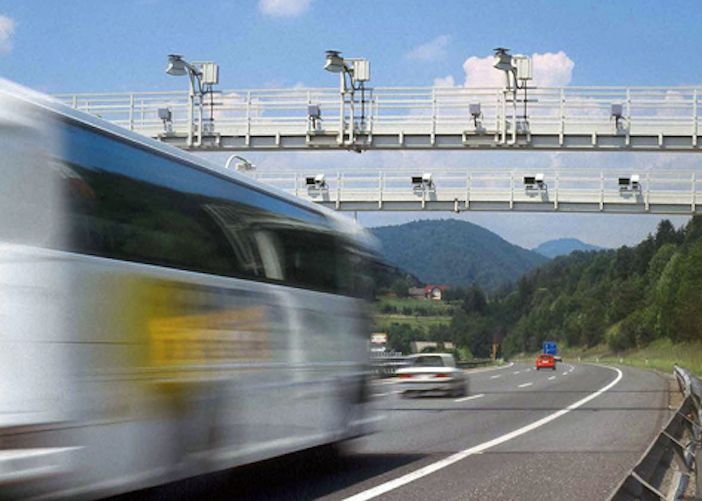Insight gained from engineering electronic back-office solutions and experience of providing managed tolling services in South Africa have led Kapsch TrafficCom to reconsider the future of automated enforcement and the company’s potential role as an enforcement service provider. There is, the company believes, a strong case for allowing some new players to enter the automated enforcement sector. Such a development would fit well with the convergence we are witnessing of the many once-discrete strands of intelligent transport systems (ITS)/road network management and enable effective solutions to be offered that work at a national or pan-regional level.
As electronic toll collection (ETC)-based road user charging (RUC) schemes have increased in size and complexity to the point where they can now cover all roads and all vehicle types within a country or region, the monolithic nature of electronic back-office systems has been challenged not so much by the existing technology’s ability to cope as by procurers’ desire to mitigate risk by using multiple suppliers. That has led to major procurements, which have required technology developers and manufacturers to be prepared to break into their own complete solutions and supply only a part of an overall scheme, such as transaction handling, enforcement or the roadside and in-vehicle technologies which facilitate electronic transactions.
France’s Ecotaxe scheme is an example of a recent procurement where several often-competing companies have been obliged to enable their systems to work with each other’s. Kapsch is one of several technology suppliers to Ecotaxe, which perhaps sets something of a trend with its multiple-sourcing procurement strategy but, arguably, moves towards pan-European Union (EU) interoperability and the establishment of a European electronic toll service (EETS) have much the same consequences, in that in the future systems suppliers cannot presume to have a monopoly and must get used to having their previously complete and discrete solutions – for which they can guarantee levels of performance by virtue of being in control of all elements of the RUC process – procured and used in a piecemeal fashion.
Modular solution
This has led Kapsch to develop a new, modular back-office approach that includes all the necessary elements of RUC but that also allows them be separated out into the individual functions. These can then be supplied in combinations to suit customers’ wishes but the new approach also means that functions such as enforcement can be delivered as discrete packages. It is enabling the company, regarded by many solely as an RUC system supplier, to think of itself for the first time as an enforcement specialist.
There are other developments that are provoking thought change. These are outside the back office but still related to the interest in countrywide RUC schemes, which by their nature look to carry out enforcement before a vehicle crosses a national boundary and revenues owed are lost.
In a national, all-roads-and-vehicles RUC scheme that uses ETC, mobile enforcement is employed. Data from vehicles’ dedicated short-range communication (DSRC) on-board units (OBUs) are read and compared with information held by the back office, and mismatches are dealt with accordingly. More recently, Kapsch has developed a vehicle-based enforcement solution that uses automatic licence plate recognition (ALPR) to provide an at-the-roadside capability. The enforcement vehicle effectively acts as a mobile gantry and ALPR data is passed between the vehicle and the back office for processing in real time, enabling on-the-spot payment for missed tolls.
At a slightly greater remove from the RUC systems manufacturers’ influences, EU-inspired projects such as EUCARIS (the EUropean CAR and driving license Information System) and its follow-ons/related projects, as well as safety initiatives such as eCall, are also providing a spur.
Cross-border cooperation
The sharing across several national borders of vehicle and driver licensing information is a great potential facilitator of large-scale enforcement schemes. These can be tied to RUC, and Kapsch has an established track record of being very successful at capturing potentially lost tolling revenues. Looking more broadly, however, the experience of operating in South Africa – where Kapsch provides managed tolling services – has been enlightening. There, if a vehicle is stopped for a toll violation, all other aspects of ownership and entitlement to drive are checked. This includes the driver’s credentials, vehicle roadworthiness documents, road tax and so on.
The South African experience, which to date has proven to be a highly positive one in terms of improving safety and reducing poor or illegal driving, provides a reference deployment. It demonstrates how a major tolling provider is already expanding upon enforcement operations related solely to RUC. In terms of delivering a similar service elsewhere, such as in the EU, a lot depends on the right legislation being in place and on whether customers – principally public-sector organisations – are comfortable with the idea of handing over the running of such services to a private-sector provider. With both of these criteria satisfied, however, real-world operations could follow really rather quickly.
Expanding the concept and the proposition even further, consideration has to be given to convergence. The tolling and ITS sectors have been edging ever-closer to each other over the last few years as a consequence of natural progressions within both technology development (where, for instance, we are seeing the use of common technologies such as IP-based communications and, therefore, common skillsets) and procurement (where agencies have been looking to procure complete ITS solutions which combine a financing, revenue-generating or demand-management capability with transport network management capabilities).
Behind the scenes
In Kapsch’s case, convergence has led to some highly targeted acquisitions. It has also resulted in the setting up of a new business unit that complements that which deals with RUC. Kapsch Back Office, the product that underpins the enforcement offering, takes an unusual back-office-to-front-edge approach which leans upon the company’s RUC heritage. Kapsch Back Office is technology-agnostic in terms of what can be used at the front end and, as has been demonstrated by the South African deployment, can be used to trigger mobile enforcement units and deliver a real-time enforcement capability.
In many instances, however, the existing infrastructure used for RUC can also be re-employed to enforce against offences more related to safety and traffic management than revenue capture. It is perfectly possible to utilize a tolling scheme’s existing tolling gantries with their DSRC OBU and ALPR technologies to provide section-based speed control, for instance. There is no need to overlay additional, specialised enforcement technology.
Where partnering with an RUC provider for enforcement brings major advantage is in terms of diversity. Dynamic vehicle classification, including dimensions and weight, can be allied with commercial vehicle operations (CVO) applications as well as access control and ‘classic’ enforcement applications such as speed and red light monitoring. All of this can be done in a manner that allows seamless integration with traffic management systems from the same portfolio. However, access across national boundaries to other countries’ vehicle registers and databases will be a real game-changer. RUC providers are at a real advantage here. EETS may have had a troubled gestation but there is the political will at the European level to see it through and, in the meantime, there are a growing number of regional EETS-type agreements which are already well-placed to take advantage of RUC/enforcement convergence. Kapsch’s involvement in RUC places it in the vanguard of international managed services for enforcement as the concept gains recognition and acceptance, and there is a sound supporting business model that combines RUC, CVO and management of civil offences.
A back-to-front solution
Kapsch Back Office is a comprehensive enforcement ‘engine’ that will support the vast majority of, if not all, enforcement applications. These include toll enforcement, red light, spot and section speed control as well as weigh-in-motion (WIM) and commercial vehicle identification/validation. In addition, the solution offers traffic surveillance functionalities intended to increase public security.
Whereas many enforcement system manufacturers and suppliers are specialists in Front-End Devices (FEDs)/edge-of-network (typically camera) technologies, Kapsch has addressed the needs of enforcement with a back-end solution which recognises that most data exchanges also typically include a payment element – whether this be for data/information services, or in the form of reconciliation of a violation.
As a result, this solution is a back-to-front rather than a front-to-back platform and is technology-agnostic in the sense that it can link to any FED. A front-end integration layer sits between it and any FEDs. Kapsch Back Office will accept metadata in any format but will store it in a single, usable form which is pre-agreed with the customer or user. In the case of an infringement the primary evidence is also retained should this for any reason be needed again later.
This approach has some important benefits. It means that the solution addresses the homologation issue by using already-homologated FEDs. As a result the deployment process is simpler, the all-important evidence chain is preserved and workflow within the enforcement process is seamless. It also means that it is adaptable. Kapsch can supply FEDs where this is desired or necessary – besides toll enforcement solutions the company offers, for instance, its own branded WIM solution as well as camera technology from its traffic management portfolio. However Kapsch recognises that local conditions, be they legacy/preferred technologies, geography and weather or budgetary factors can all have a huge bearing on final FED choices.
Kapsch Back Office operates seamlessly with traffic management solutions supplied by its parent company. The platform’s philosophy also recognises that enforcement and traffic management are not mutually exclusive. In the case of WIM, for example, data is not just needed to enforce against overloads but can also be held and mined at a later date for maintenance purposes or to gain a better impression of a road’s usage profile. An intrinsic FED data store provides for this very need.
www.kapsch.net





